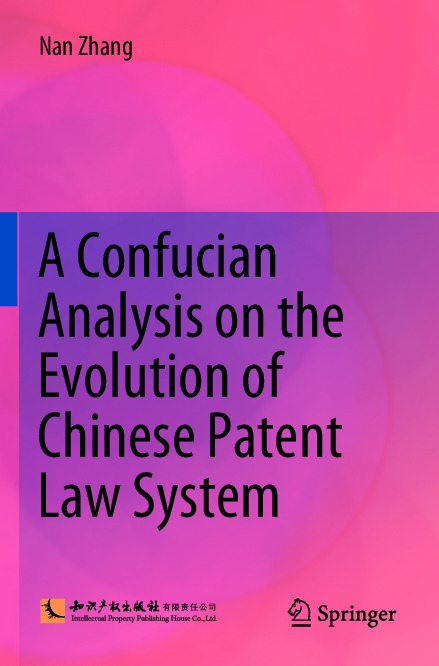File #2838: "2020_Book_AConfucianAnalysisOnTheEvoluti.pdf"
Testo
1|Contents|5
1|Abbreviations|8
1|List of Charts|10
1|1 Introduction|11
2|1.1 Clarifications of the Arguments and Contributions|11
2|1.2 Literature Review|12
2|1.3 Research Methodology|14
1|2 A Brief History of Chinese Innovation|15
2|2.1 Changes of Social Group and the Booming of Patents|15
3|2.1.1 The New Social Changes Brought About by Industrialisation|15
3|2.1.2 The British Industrialists and Patents|17
3|2.1.3 Chinese Industrialists and Patents|19
2|2.2 Industrialism and International Trade|24
3|2.2.1 What Happened in the Past|24
3|2.2.2 What is Happening Now|25
2|2.3 The Rise of a Creative Group|26
2|2.4 Cultural Strategies for Legal Enforcement|27
1|3 A Consideration of IP Through a Confucian Exploration|28
2|3.1 Introduction|28
2|3.2 The Origin of Chinese Civilization|29
2|3.3 Confucius|30
3|3.3.1 Confucius and His Historical Background|30
3|3.3.2 “Four Books and Five Classics”|34
3|3.3.3 Confucius’s Social, Educational and Moral Impact|43
3|3.3.4 His Moral Impact: “Ren”, “Lun”, and “Li”|49
2|3.4 Conclusion|52
1|4 The Ancient Innovation and Early Chinese Patent Law|53
2|4.1 Introduction|53
2|4.2 Examples of Ancient Innovations|53
3|4.2.1 The Armillary Sphere|53
3|4.2.2 The Compass|54
3|4.2.3 The Development of Paper Making|55
3|4.2.4 Printing|56
3|4.2.5 Gun Powder|57
2|4.3 Early Chinese Patent Law|58
3|4.3.1 Introduction|58
3|4.3.2 The Seed of Chinese Patent Law|59
3|4.3.3 Patent Legislation 1912–1949|60
3|4.3.4 Patent Legislation 1949–1963|61
3|4.3.5 Chinese Patent Law 1984|62
1|5 China’s Updates in Patent Law|65
2|5.1 Introduction|65
2|5.2 The 1992 Amendment|65
2|5.3 The 2001 Amendment|66
2|5.4 The 2009 Amendment|67
2|5.5 The Entry into Patent Cooperation Treaty (PCT)|69
2|5.6 International Trainings|70
2|5.7 Patent Rights|71
3|5.7.1 Types of Patent Rights|71
3|5.7.2 Examination on Invention, Utility Model and Design Patents|75
3|5.7.3 Patent Licences|77
3|5.7.4 Injunctions|80
3|5.7.5 Preservation of Evidence|82
3|5.7.6 Patent Infringement Actions|84
3|5.7.7 Non-infringement Actions|85
3|5.7.8 False Marking Actions|94
3|5.7.9 Non False Marking Defence|96
3|5.7.10 The Civil Liabilities and Remedies|96
3|5.7.11 Administrative Liabilities and Remedies|99
3|5.7.12 Criminal Liabilities and Remedies|102
2|5.8 Chinese IP Tribunals|104
2|5.9 Compulsory Licensing|106
2|5.10 Conclusion|110
1|6 New Waves in Chinese Patent Law System|111
2|6.1 Introduction|111
2|6.2 New Article 6 of the Draft of the Fourth Amendment and the Draft of the Regulation on Employment Inventions|111
2|6.3 New Article 43 of the Draft of the Fourth Amendment|113
2|6.4 New Article 50–52 of the Draft of the Fourth Amendment|114
2|6.5 New Article 69 of the Draft of the Fourth Amendment|115
2|6.6 New Article 70 of the Draft of the Fourth Amendment|116
2|6.7 New Article 71 in the Draft of the Fourth Amendment|117
2|6.8 Chinese Patent Enforcement Measures 2011 and Its 2015 Revision|117
2|6.9 New Article 72 of the Draft of the Fourth Amendment|118
3|6.9.1 Increase of Statutory Compensation|118
3|6.9.2 The New Adoption of Punitive Compensation|120
3|6.9.3 Increase of the Judicial Power in Collecting Evidence|121
2|6.10 The Establishment of New IP Courts|121
2|6.11 Conclusion|122
1|7 Conclusion: Cultural Strategies for IP Enforcement|123
2|7.1 Key Principles in Each Chapter of This Book|123
2|7.2 Enforcement is the Agenda: Five Strategies|124
3|7.2.1 Education|124
3|7.2.2 Creating an IP Culture in China|127
3|7.2.3 Benefits of Both Local and Overseas Patent Right Holders|130
3|7.2.4 Creative Group and IP|131
3|7.2.5 Patent Portfolio and Branding|132
2|7.3 A More Detailed Plan for Action|134
1|Bibliography|138
1|Abbreviations|8
1|List of Charts|10
1|1 Introduction|11
2|1.1 Clarifications of the Arguments and Contributions|11
2|1.2 Literature Review|12
2|1.3 Research Methodology|14
1|2 A Brief History of Chinese Innovation|15
2|2.1 Changes of Social Group and the Booming of Patents|15
3|2.1.1 The New Social Changes Brought About by Industrialisation|15
3|2.1.2 The British Industrialists and Patents|17
3|2.1.3 Chinese Industrialists and Patents|19
2|2.2 Industrialism and International Trade|24
3|2.2.1 What Happened in the Past|24
3|2.2.2 What is Happening Now|25
2|2.3 The Rise of a Creative Group|26
2|2.4 Cultural Strategies for Legal Enforcement|27
1|3 A Consideration of IP Through a Confucian Exploration|28
2|3.1 Introduction|28
2|3.2 The Origin of Chinese Civilization|29
2|3.3 Confucius|30
3|3.3.1 Confucius and His Historical Background|30
3|3.3.2 “Four Books and Five Classics”|34
3|3.3.3 Confucius’s Social, Educational and Moral Impact|43
3|3.3.4 His Moral Impact: “Ren”, “Lun”, and “Li”|49
2|3.4 Conclusion|52
1|4 The Ancient Innovation and Early Chinese Patent Law|53
2|4.1 Introduction|53
2|4.2 Examples of Ancient Innovations|53
3|4.2.1 The Armillary Sphere|53
3|4.2.2 The Compass|54
3|4.2.3 The Development of Paper Making|55
3|4.2.4 Printing|56
3|4.2.5 Gun Powder|57
2|4.3 Early Chinese Patent Law|58
3|4.3.1 Introduction|58
3|4.3.2 The Seed of Chinese Patent Law|59
3|4.3.3 Patent Legislation 1912–1949|60
3|4.3.4 Patent Legislation 1949–1963|61
3|4.3.5 Chinese Patent Law 1984|62
1|5 China’s Updates in Patent Law|65
2|5.1 Introduction|65
2|5.2 The 1992 Amendment|65
2|5.3 The 2001 Amendment|66
2|5.4 The 2009 Amendment|67
2|5.5 The Entry into Patent Cooperation Treaty (PCT)|69
2|5.6 International Trainings|70
2|5.7 Patent Rights|71
3|5.7.1 Types of Patent Rights|71
3|5.7.2 Examination on Invention, Utility Model and Design Patents|75
3|5.7.3 Patent Licences|77
3|5.7.4 Injunctions|80
3|5.7.5 Preservation of Evidence|82
3|5.7.6 Patent Infringement Actions|84
3|5.7.7 Non-infringement Actions|85
3|5.7.8 False Marking Actions|94
3|5.7.9 Non False Marking Defence|96
3|5.7.10 The Civil Liabilities and Remedies|96
3|5.7.11 Administrative Liabilities and Remedies|99
3|5.7.12 Criminal Liabilities and Remedies|102
2|5.8 Chinese IP Tribunals|104
2|5.9 Compulsory Licensing|106
2|5.10 Conclusion|110
1|6 New Waves in Chinese Patent Law System|111
2|6.1 Introduction|111
2|6.2 New Article 6 of the Draft of the Fourth Amendment and the Draft of the Regulation on Employment Inventions|111
2|6.3 New Article 43 of the Draft of the Fourth Amendment|113
2|6.4 New Article 50–52 of the Draft of the Fourth Amendment|114
2|6.5 New Article 69 of the Draft of the Fourth Amendment|115
2|6.6 New Article 70 of the Draft of the Fourth Amendment|116
2|6.7 New Article 71 in the Draft of the Fourth Amendment|117
2|6.8 Chinese Patent Enforcement Measures 2011 and Its 2015 Revision|117
2|6.9 New Article 72 of the Draft of the Fourth Amendment|118
3|6.9.1 Increase of Statutory Compensation|118
3|6.9.2 The New Adoption of Punitive Compensation|120
3|6.9.3 Increase of the Judicial Power in Collecting Evidence|121
2|6.10 The Establishment of New IP Courts|121
2|6.11 Conclusion|122
1|7 Conclusion: Cultural Strategies for IP Enforcement|123
2|7.1 Key Principles in Each Chapter of This Book|123
2|7.2 Enforcement is the Agenda: Five Strategies|124
3|7.2.1 Education|124
3|7.2.2 Creating an IP Culture in China|127
3|7.2.3 Benefits of Both Local and Overseas Patent Right Holders|130
3|7.2.4 Creative Group and IP|131
3|7.2.5 Patent Portfolio and Branding|132
2|7.3 A More Detailed Plan for Action|134
1|Bibliography|138

